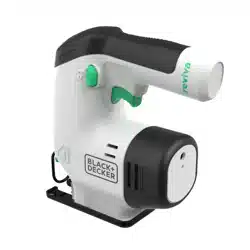Loading ...
Loading ...
Loading ...

5
ENGLISH
READ ALL INSTRUCTIONS
Important Safety Instructions for All
Integral Battery Tools
WARNING: Read all safety warnings, instructions,
and cautionary markings for the battery, charger
and product. Failure to follow the warnings and
instructions may result in electric shock, fire and/
or seriousinjury.
• NEVER force a charger cord plug into thetool.
• DO NOT
modify
a charger cord
plug of a
non‑compatible charger in any way to fit into the
tool as the battery may rupture causing serious
personalinjury.
Only for use with S010QU1400040chargers.
BATTERY AND CHARGER
The battery is not fully charged out of the carton. Before using
the charger to charge the battery, read the safety instructions
below and then follow charging proceduresoutlined.
The RBRC® Seal
Please take your spent battery packs to
an authorized BLACK+DECKER service
center or to your local retailer for recycling.
In some areas, it is illegal to place spent
battery packs in the trash. You may also contact your local
recycling center for information on where to drop off the
spent battery pack. Do not place in curbside recycling. For
more information visit www.call2recycle.org. or call the toll
free number in the RBRC®Seal.
RBRC® is a registered trademark of Call 2Recycle,Inc.
The label on your tool may include the following symbols. The
symbols and their definitions are asfollows:
V ......................... volts
Hz .......................hertz
min ..................... minutes
or DC ......direct current
...................... Class I Construction
(grounded)
…/min ..............per minute
BPM .................... beats per minute
IPM ..................... impacts per minute
OPM .................... oscillations per
minute
RPM .................... revolutions per
minute
sfpm ................... surface feet per
minute
SPM .................... strokes per minute
A ......................... amperes
W ........................watts
Wh ......................watt hours
Ah ....................... amp hours
or AC ...........alternating current
or AC/DC .... alternating or direct
current
...................... Class II Construction
(double insulated)
n
o
.......................no load speed
n .........................rated speed
PSI....................... pounds per square
inch
......................earthing terminal
.....................safety alert symbol
..................... visible radiation
do not stare into
the light
..................... wear respiratory
protection
..................... wear eye protection
..................... wear hearing
protection
..................... read all
documentation
..................... do not expose to
rain
Additional Safety Information
WARNING: Never modify the power tool or any part of
it. Damage or personal injury couldresult.
WARNING: ALWAYS use safety glasses. Everyday
eyeglasses are NOT safety glasses. Also use face or
dust mask if cutting operation is dusty. ALWAYS WEAR
CERTIFIED SAFETYEQUIPMENT:
• ANSI Z87.1 eye protection (CAN/CSA Z94.3),
• ANSI S12.6 (S3.19) hearing protection,
• NIOSH/OSHA/MSHA respiratoryprotection.
WARNING:
Some dust created by power sanding,
sawing, grinding, drilling, and other construction activities
contains chemicals known to the State of California to
cause cancer, birth defects or other reproductive harm.
Some examples of these chemicalsare:
• lead from lead‑based paints,
• crystalline silica from bricks and cement and other
masonry products, and
• arsenic and chromium from
chemically‑treatedlumber.
Your risk from these exposures varies, depending on
how often you do this type of work. To reduce your
exposure to these chemicals: work in a well ventilated
area, and work with approved safety equipment, such
as those dust masks that are specially designed to filter
out microscopicparticles.
• Wear protective clothing and wash exposed areas
with soap and water. Allowing dust to get into your
mouth, eyes, or lay on the skin may promote absorption of
harmfulchemicals. Direct particles away from face andbody.
• Use the appropriate dust extractor vacuum to remove
the vast majority of static and airborne dust. Failure
to remove static and airborne dust could contaminate the
working environment or pose an increased health risk to
the operator and those in closeproximity.
• Use clamps or other practical ways to secure and
support the workpiece to a stable platform. Holding
the work by hand or against your body is unstable and may
lead to loss of control andinjury.
• Air vents often cover moving parts and should be
avoided. Loose clothes, jewelry or long hair can be caught
in movingparts.
CAUTION: When not in use, place tool on its
side on a stable surface where it will not cause
a tripping or falling hazard. Some tools with large
battery packs will stand upright on the battery pack
but may be easily knockedover.
• Keep your hands away from cutting area. Do not reach
under the material beingcut.
• Do not use dull or damaged blades. Bent blade can
break easily or cause kickback. Exercise extreme caution
when handling the accessories. The accessories are very
sharp. Wear protective gloves when changing cutting
accessories. Accessories become hot after prolongedusage.
Loading ...
Loading ...
Loading ...
